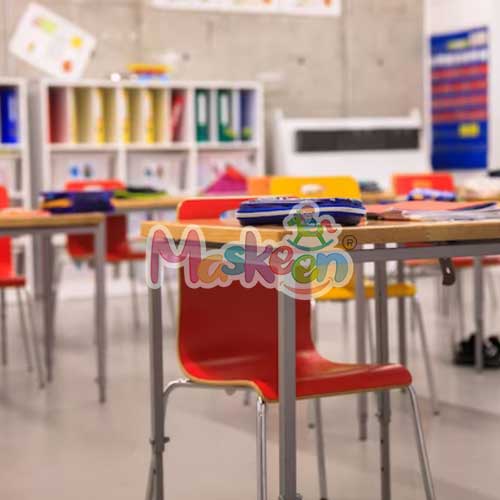- Toys
- Soft Play Equipment
- Trampoline
- School Furniture
- Exhibitions
- Achievements
- New Arrivals
- About Us

As educators and administrators seek to cultivate dynamic learning environments, the significance of school furniture cannot be overstated. Beyond mere utility, well-designed furniture plays a pivotal role in shaping the atmosphere and functionality of classrooms and educational spaces. In this article, Maskeen Overseas, as one of the top School Furniture Manufacturers, explores three key ways in which thoughtful furniture choices can foster both playfulness and productivity in learning settings.
Gone are the days of rigid, uniform desks and chairs. Today's Classroom Furniture Manufacturers like Maskeen Overseas, recognize the importance of versatility and creativity in design. By offering a diverse range of seating options—from ergonomic chairs to flexible seating arrangements—students are empowered to choose environments that best suit their learning preferences. This variety encourages movement and collaboration, keeping students actively engaged in their learning process.
Moreover, innovative designs can transform traditional classroom spaces into hubs of creativity and exploration. Mobile desks and adjustable tables allow for seamless transitions between individual work, group activities, and presentations. Height-adjustable furniture accommodates students of all ages and sizes, promoting inclusivity and comfort. By embracing such forward-thinking designs, educators can create dynamic spaces that inspire curiosity and foster a sense of ownership among students.
In recent years, there has been a growing recognition of the benefits of outdoor learning environments. As Outdoor Play Station Manufacturers, like Maskeen Overseas, continue to innovate, schools are increasingly incorporating nature-inspired elements into their educational spaces. From outdoor classrooms to nature-themed play areas, these initiatives offer students valuable opportunities to connect with the natural world while engaging in hands-on learning experiences.
For example, a school might invest in outdoor seating areas surrounded by greenery, providing students with a tranquil setting for reading or group discussions. Natural materials such as wood and stone can be used to create seating structures that blend seamlessly with the surrounding environment. Additionally, playground equipment designed to mimic natural landscapes—such as logs for balancing and rocks for climbing—encourages physical activity and imaginative play.
By embracing outdoor learning opportunities, schools not only promote environmental stewardship but also enhance students' cognitive abilities and overall well-being.
Collaborative learning lies at the heart of modern education, and Classroom Furniture plays a crucial role in facilitating meaningful interactions among students. Flexible seating arrangements, such as modular tables and lounge-style seating, encourage teamwork and communication. By breaking away from the traditional classroom setup, educators can create spaces that promote collaboration and foster creativity.
Moreover, furniture that supports technology integration enables students to seamlessly transition between digital and analog learning modalities. Adjustable desks with built-in charging stations and cable management systems accommodate laptops and tablets, facilitating interactive lessons and multimedia presentations. By embracing technology-friendly furniture solutions, schools equip students with the tools they need to thrive in an increasingly digital world.
In conclusion, the design and selection of school furniture are pivotal in creating playful and productive learning environments. By embracing innovative designs, integrating outdoor elements, and prioritizing collaboration and creativity, educators can transform traditional classrooms into dynamic spaces that inspire curiosity, foster engagement, and support student success. As schools continue to prioritize the holistic development of their students, investing in high-quality furniture from reputable manufacturers becomes essential in shaping the future of education.